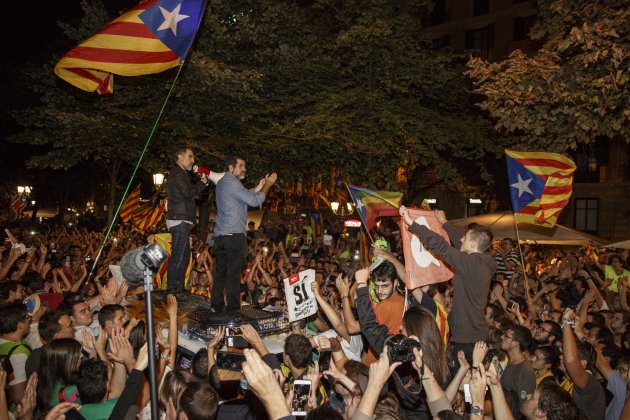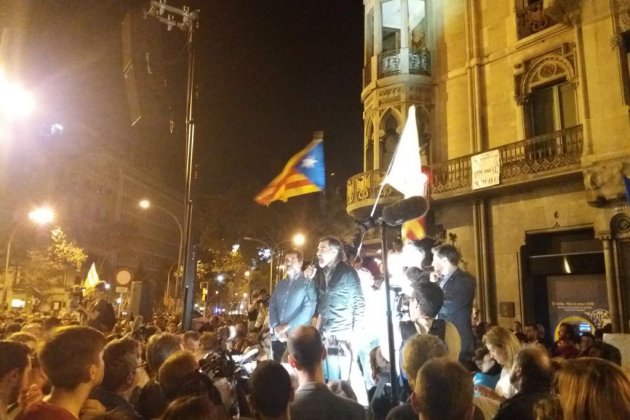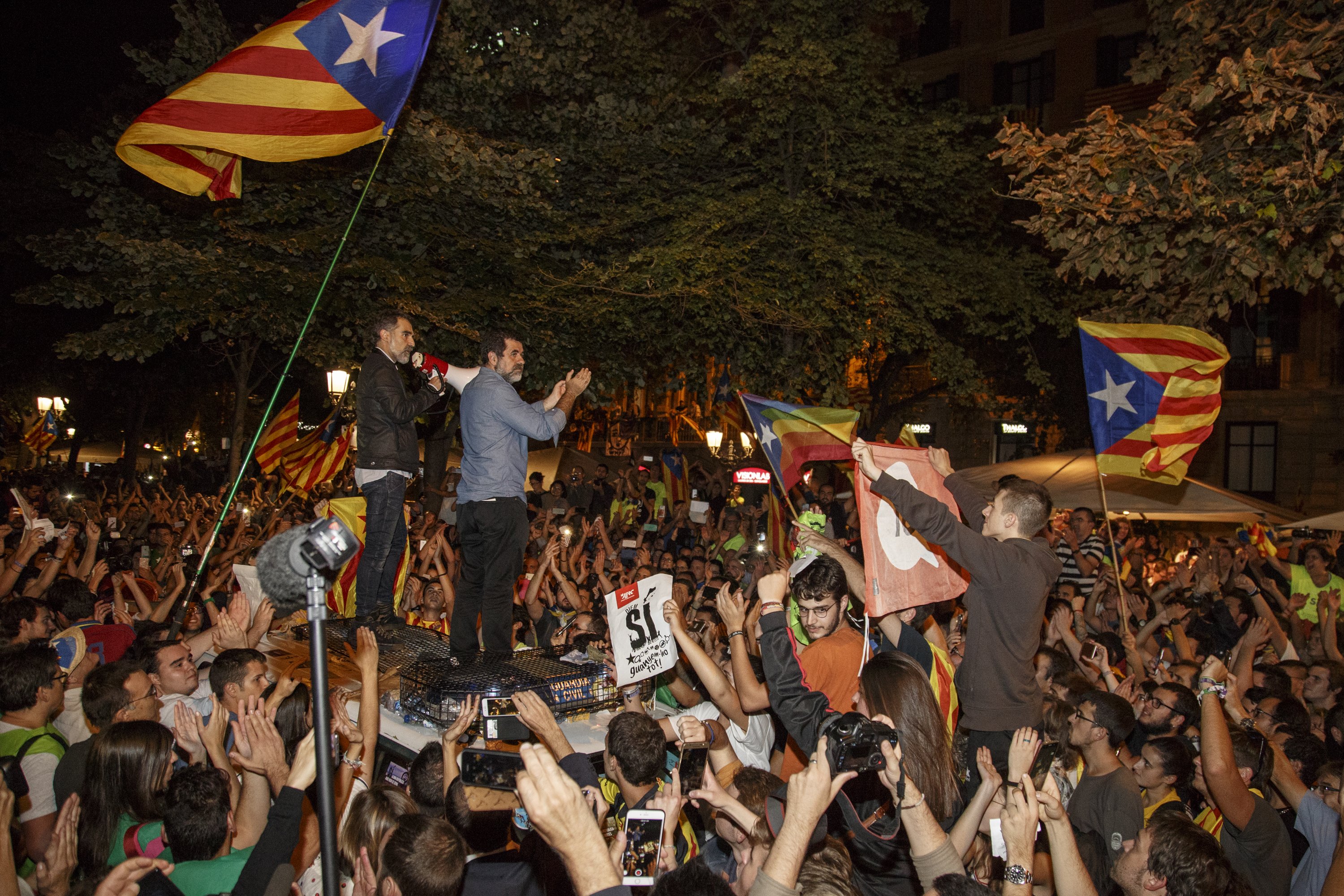Today marks a year since leading Catalan pro-independence activists Jordi Sànchez and Jordi Cuixart were sent to Soto del Real prison for pretrial detention after appearing before Madrid's National Audience court accused of sedition. It was the second time they'd headed to Madrid, alongside the then head of the Mossos d'Esquadra (Catalan police), Josep Lluís Trapero. Public prosecutors were relentless and asked for pretrial detention without bail; judge Carmen Lamela accepted.
The initial complaint of sedition following the events of 20th September had ended up becoming a lawsuit for rebellion including the 1st October referendum.
On 16th October, they were put behind bars at Soto del Real prison (Madrid); on 4th July they were moved to Lledoners prison (Catalonia), where they remain, alongside the other male political prisoners: Oriol Junqueras, Raül Romeva, Jordi Turull, Josep Rull and Quim Forn. Carme Forcadell is in Mas de l'Enric and Dolors Bassa, Puig de les Basses.
The case against the Jordis is full of incongruities, and the accusations have varied as the investigation has progressed.
From the very start, however, the Civil Guard vehicles the Jordis climbed onto to dissolve the protest on 20th September outside the Catalan economy ministry have been at the centre of the narrative and the accusations. That protest took place whilst Civil Guard officers were inside the department, searching for material related to the referendum and holding a number of senior officials.
The seriousness of the situation grew when the Civil Guard informed the Mossos d'Esquadra that they had left weapons in the vehicles now surrounded by hundreds of people. Various solutions were proposed, but the gendarmes refused them one-by-one.
The last suggestion El Nacional has learnt of was an offer from the Mossos to form a path from the economy ministry's doors to the cars for the Civil Guard to use to remove their weapons. But the Spanish police didn't want to. They wanted to avoid the image of Civil Guard officers entering the ministry carrying weapons.
Nor did they want to move their vehicles to the department's car park. In the end, ANC set up a security cordon of volunteers to avoid anyone else getting on the cars. Meanwhile, the Mossos' helicopter kept them in sight at all times.
Indeed, when one of the demonstrators put their head in one of the cars, the helicopter reported it to those one the ground, at which point Mossos anti-riot officers took action to clear the area.
The Mossos learnt there were weapons in the vehicles in the morning; Jordi Sànchez, that afternoon, and Jordi Cuixart, into the evening.
As for the cordon protecting the cars, that also ended up being a weapon against the Spanish state according to legal documents. The complaint says that the volunteers formed the cordon "to avoid the Civil Guard taking away the detainees", which cause "high-tension situations".
Can't do any more harm
Cuixart entered the ministry for the first time at 10pm. Before then, he had already visited the protest a number of times during the day. During the night, he spoke directly with the Civil Guard three or four times. This was when it was decided to dissolve the rally.
There are two key moments from this time which ended up being the basis of the accusation against the Jordis and which haven't been taken into account when reviewing the charges against them.
The first, the fact that the Civil Guard said they didn't have to dissolve the demonstration because, with them, the crowd was under control.
The second, the approval they gave to use their cars as a platform to address the crowd. Jordi Sànchez told a Civil Guard superintendent that they would get on the vehicles to tell the crowd to leave. The officer replied that it couldn't do the car any more harm.

The photo with the two Jordis on the car was used as evidence against them in the first complaint, which spoke of sedition and "small-scale rebellion", a charge doesn't exist in the penal code.
The second call for the demonstrators to dissolve the demonstration wasn't only made from on top of the cars, but also from the stage with a megaphone. This image, however, doesn't appear in the Civil Guard's complaint or report.

But, in the decree sending them to prison, judge Carmen Lamela gave a different interpretation of events: "On top of a Civil Guard car, they called for a permanent demonstration from that day on in favour of the referendum and in opposition to the legally ordered actions to prevent it".
The judge said that both Sànchez and Cuixart "stood up as spokespeople for the gathering" and that "they never used" this position "to dissolve [it] or reduce the risks".
She adds that, despite the requests for the rallies to be peaceful, "no message was sent, nor was the crowd informed in any other way that they shouldn't damage the official vehicles".
The judge claims that "it wasn't really a question of peaceful demonstrations and nor of one isolated protest against specific actions by the court of the Civil Guard" and that Sànchez and Cuixart "addressed the demonstrators, encouraging the crowd".
Lamela is harsh in her report, saying that "of special importance is the role the two people under investigation played in the events which are the subject of the present procedure, actively participating in calling for the gatherings which took place on the 20th and 21st September, raising themselves up moreover as their principle promoters and directors, keeping this position during the whole day, taking the initiative in a supposed negotiation with the Civil Guard, encouraging and directing the action of those gathered there, inciting them to remain in the place and giving orders for what to do at all times".
"Small-scale rebellion"
The lawsuit presented to the National Audience court on 22nd September still didn't include Sànchez and Cuixart's names, but did point in their direction.
Prosecutors believed that the events constituted a crime of sedition, a "collective and tumultuous uprising" or "small-scale rebellion", they wrote. They claim "the final aim of these mobilisations is to achieve the holding of the referendum to achieve the proclamation of a Catalan republic, independent of Spain, and they're aware that they're carrying out actions on the margins of legal channels, preventing the application of the law in its totality and, in particular, of the fundamental rules of all Spaniards, the Constitution".
As such, they called for an investigation to be opened into the events for "the discovery of those possibly responsible". It turned out that, for the prosecutors, that was Sànchez and Cuixart.

